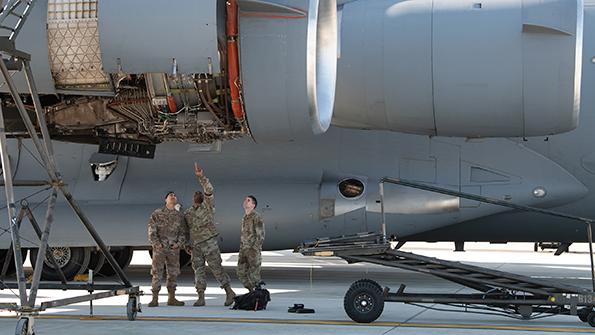
The U.S. Air Force’s logistics enterprise has massive amounts of data streaming in constantly—on the health of aircraft and the status of parts supply, fuel levels and force protection at bases and of aircraft in long-term maintenance, among many other sets of information.
- Logisticians want AI and machine learning instead of spreadsheets
- BLADE program looks to lower the barrier for logistics analytics
Making sense of this data by bringing it together for meaningful analysis requires spreadsheets upon spreadsheets, with extensive manual effort needed to collect new numbers from squadrons across the service. This eventually means a logistical snapshot is outdated by the time it is put together. But a team in the service’s logistics staff is working to change that by building its first artificial-intelligence-driven data system, called the Basing & Logistics Analytics Data Environment (BLADE), that officials say can change how maintenance is planned, sorties are scheduled and even how deployments are prepared.
“BLADE is our first real foray into bringing that artificial intelligence and machine learning on top of the data that we collect. . . . It’s going to be the vehicle by which we get away from the manual spreadsheets [and] from asking the wings and the groups and the squadrons to send us data so that we can put it into a spreadsheet, so we can get people visibility, which is then outdated 10 min. after we put it together,” says Lt. Gen. Warren D. Berry, deputy chief of staff for logistics, engineering and force protection.
BLADE brings together information from more than 300 Air Force and broader Defense Department data sources, using a Pentagon analytics platform called Advana to make the broad swaths of information more accessible, in one place. The Pentagon platform was created by Booz Allen Hamilton, and Air Force officials say BLADE supports several web-based industry-standard programs, storage services and analytic platforms and can host unclassified, classified and top secret information.
The Air Force designers and officials behind the effort want to make the hardest part of current analytics—wrangling the data itself—faster and easier so commanders make speedier decisions, logisticians can obtain the right parts more quickly and maintainers can schedule maintenance more effectively. This goes for both local base sortie schedules and combatant commanders planning upcoming deployments.
“If I can predict something is going to happen . . . I can do that maintenance at a time and place of my choosing; I can work that into my schedule,” Berry says.
The Air Force has expanded its artificial-intelligence-powered predictive maintenance tools, called Condition-Based Maintenance Plus, to 16 of its aircraft fleets. The goal with BLADE goes beyond that by bringing in many other datasets for more complete planning outside of just predicting when a specific part will fail.
A case in point: A fighter unit planning its upcoming flight schedule or a deployment can look at predictive maintenance fleet data and the status of the deployed location to determine when a part will need replacing—and whether the base has the parts and on-site contract support ready to make the needed repairs. If that base is not ready, what other locations have the necessary maintenance capacity and force protection for combat aircraft?
Since it collects data from installation and mission support, the program will quickly show if these bases have sufficient open ramp space, fuel to support the potential operations, munitions storage, food and beds for personnel and if there is enough stable electricity to power increased operations, among other factors.
“It isn’t going to eliminate unscheduled maintenance, but it has a real opportunity to dramatically reduce unscheduled maintenance,” Berry says. “Here’s the other thing: It gives me predictive supply. So not only do I have the ability to execute repairs at a time and place of my choosing because I can change that part out before it ever breaks. My supply system is going to be so much better informed.”
The program comes after similar efforts within the logistics enterprise, such as the existing Logistics, Installations and Mission Support-Enterprise View, which has a much smaller number of integrated sources and less ability for broad analytics. Officials say BLADE will be fully operational by the end of 2024, as the system is refined and more datasets are included. Though initial operational capability is still more than two years away, the service’s logistics and force protection enterprise is using BLADE with the goal of all Air Force, joint and combined forces being able to use it.

